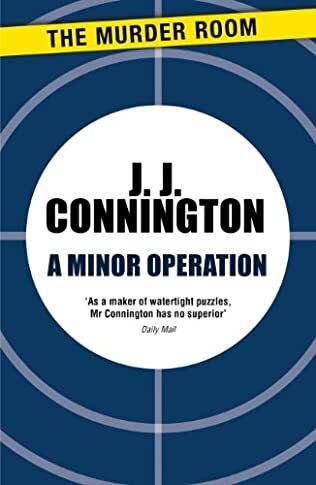A Minor Operation

A review of A Minor Operation by J J Connington
I have long been fascinated by the impact of the state of a painter’s eyesight on the type and style of paintings that they produce, an examination of the difference in style and approach in the early and later works of J M W Turner being a classic example. In A Minor Operation, the eleventh in Connington’s Sir Clinton Driffield series and originally published in 1937, cataracts and their impact on an artist’s style provide a major clue that leads to the resolution of an intriguing mystery.
Connington is a master of complex plotting, red herrings, cast-iron alibis, and misdirection while, at the same time, playing fairly with his readers. We may not have a mind as mercurial as that of the Chief Constable, but we do have all the clues presented to us, some perhaps a little opaquer than others, and are able to see how they all hang together and why some initially promising leads lead nowhere. This book is a classic example of Connington at his best.
It begins as a tale of three convicts, Nicholas Adeney, whom we meet in the first chapter, who along with Deerhurst, whose shadow casts a long shadow over the plot, were jailed when their firm collapsed, and petty thief, Sturge, who is more of a bit character, who served time with the other two and resented Deerhurst for putting a spanner in his plan to offer fellow prisoners their liberty earlier than was the King’s pleasure. Deerhurst is married to Nicholas’s sister, Hazel, who wants to divorce and is planning to provoke Deerhurst upon his release to attack her in order to resume her previous relationship with an artist.
After Deerhurst’s release, Hazel’s maid discovers that her mistress is missing and that there is a small pool of blood in the drawing room. Deerstone’s body is eventually found in a secluded patch of road, having been run over, although he had earlier been hit over the head and stabbed in the chest. Sir Clinton Driffield, accompanied by his faithful Dr Watson-like “Squire” Wendover investigates and soon discovers that Hazel had left, having only taken undergarments.
Nicholas Adeney does not help his cause by taking an antagonistic stance. He had access to Hazel’s house and was seen in conversation with Sturge about the latter’s child who has eye trouble, although his alibi for the supposed time of Deerhurst’s demise seems sound. Had Hazel lured Deerhurst to the house with the telegram found in his possession and killed him, with perhaps Adeney helping to move the body, but then why had she left with only undergarments packed in a case?
Driffield finds a number of clues which, initially, seem baffling, including an electric clock which had stopped for precisely 3 hours and 44 minutes, a Braille typewriter, a pile of red lead, and an envelope containing bearer bonds to the tune of £500. Hazel, who was paranoid about fires, turned the electricity supply off when she went to bed. Who turned the power back on and why?
Love letters, the reading of which causes the Squire some serious moral qualms, a careful examination of the paintings in Hazel’s house, and the intervention of two lawyers lead Driffield to suppose that the case is less about marital relationships and more one of the consequences of the collapse of Adeney and Sons, for which both Nicholas and Deerstone were jailed.
Connington, being a chemistry professor and obsessed with the minutiae of criminal cases, revels in exploring the differences between the typefaces of different models of typewriters of the same make and the impact of using carbon paper and allows Driffield to perform a clever chemical experiment which reveals a surprising result and provides proof positive of the identity of the culprit and their motivation.
I thoroughly enjoyed the book and for once did not find Driffield’s bumptiousness overbearing. Old-fashioned Connington may be, but he knew how to construct an intriguing mystery.



